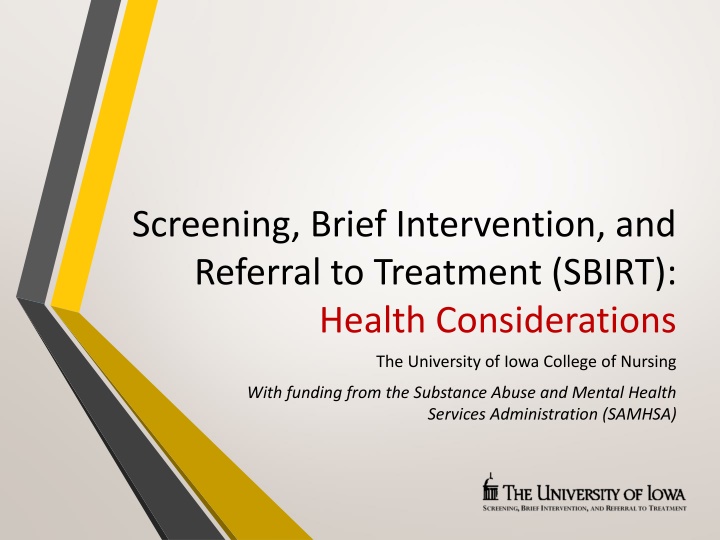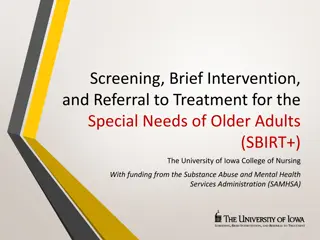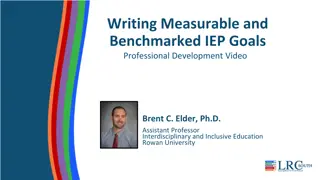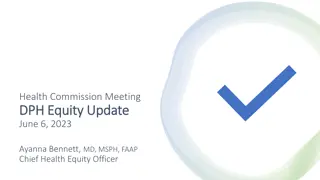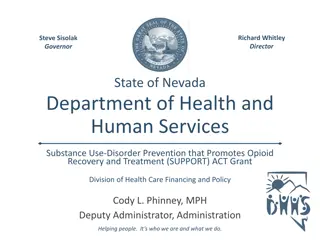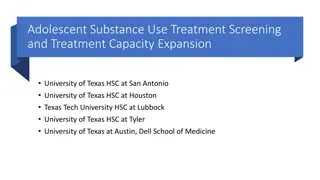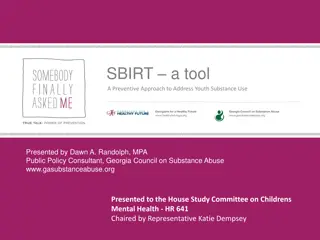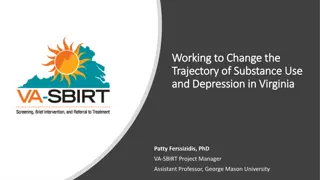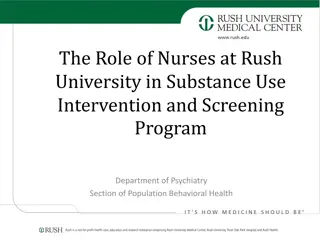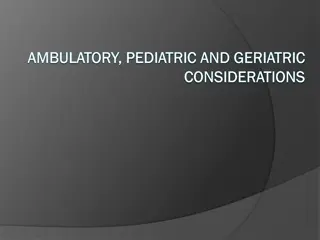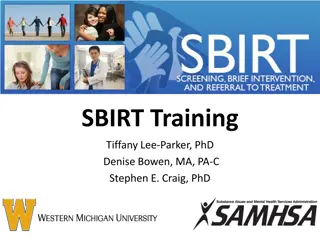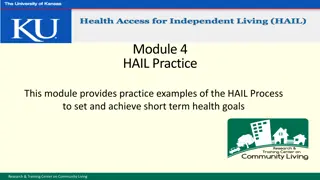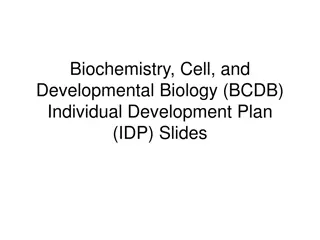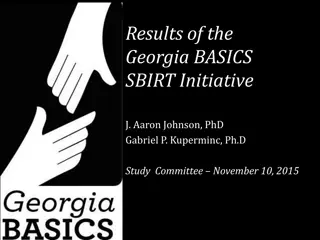SBIRT: Health Considerations and Goals for Today
Health effects, detoxification symptoms, and referral to treatment in substance use. Learn about interactions, effects on older adults, resources, and brain and heart impacts.
Download Presentation

Please find below an Image/Link to download the presentation.
The content on the website is provided AS IS for your information and personal use only. It may not be sold, licensed, or shared on other websites without obtaining consent from the author.If you encounter any issues during the download, it is possible that the publisher has removed the file from their server.
You are allowed to download the files provided on this website for personal or commercial use, subject to the condition that they are used lawfully. All files are the property of their respective owners.
The content on the website is provided AS IS for your information and personal use only. It may not be sold, licensed, or shared on other websites without obtaining consent from the author.
E N D
Presentation Transcript
Screening, Brief Intervention, and Referral to Treatment (SBIRT): Health Considerations The University of Iowa College of Nursing With funding from the Substance Abuse and Mental Health Services Administration (SAMHSA)
Goals for Today 1. Describe health effects and interactions with substance use. 2. Identify symptoms suggesting the need for detoxification and referral to treatment.
UI Branded Education Sheet for older adults Anyone who is given the AUDIT should also be provided a copy of the Education Sheet
Many Great Resources!!! Beyond Hangovers: Understanding Alcohol s Impact on Your Health https://pubs.niaaa.nih.gov/publications/hangovers/beyondHangovers.pdf Alcohol s Effects on the Body https://www.niaaa.nih.gov/alcohol-health/alcohols-effects-body Alcohol Facts and Statistics https://pubs.niaaa.nih.gov/publications/alcoholfacts&stats/AlcoholFacts&Stats.pdf Health Consequences of Drug Misuse https://www.drugabuse.gov/related-topics/health-consequences-drug-misuse
Health Assessment Data Keep substance use in mind Presenting problems/observations Physical assessment findings Lab results Collateral interviews: What are others saying? Concerned about? Health conditions may be the signal to explore substance use!
Brain Alcohol and drugs interrupt communication pathways and change brain structure and chemistry Disruptions in mood, behavior, cognition Motor coordination, sleep, temperature regulation Two special risks Prenatal alcohol exposure; fetal alcohol syndrome Adolescent substance use; affects the brain while it is still in development
Heart/Vascular Cardiomyopathy: Long-term heavy drinking (anatomic function) Arrhythmias (physiologic function) Atrial fibrillation Ventricular tachycardia Strokes Hypertension Additional risks with illicit drugs; varies by drug type
Cancer Alcohol and drug use are associated with increased risk for many types of cancer Mouth Esophagus Pharynx Larynx Liver Breast Colon Rectal
Immune System Chronic diseases are associated with impaired bone marrow function Weakens the immune system Impacts defense systems Innate Adaptive/acquired Increases susceptibility to infections and disease Pneumonia Tuberculosis
Liver Alcohol consumption increases the risk of liver damage; the amount of alcohol doesn t correlate well with the amount of damage to the liver Alcoholic hepatitis inflammation due to excessive fat in the liver Fibrosis scar tissue Cirrhosis deterioration of the liver Heroin, inhalants, steroids, and opioids liver damage
Pancreas Substance use can lead to pancreatic organ damage Heavy, long-term drinking Some drugs Increases risks for Pancreatitis Acute Chronic Pancreatic cancer
Kidney Function Alcohol can worsen kidney disease Binge drinking can lead to acute kidney failure Drugs are also associated with damage or failure Heroin Inhalants MDMA (ecstasy) PCP Of WATER, not alcohol!!!
Smoking, Tobacco, Nicotine Alcohol and tobacco are often used together Roughly 70% of people with an alcohol-related substance use disorder use tobacco products Alcohol and substance use is associated with higher rates of tobacco use Nearly 60 percent of new smokers were under the age of 18 (in 2010)
Complex Medical Problems Substance use makes it more difficult to treat underlying medical conditions, including: Cardiovascular Endocrine Autoimmune and many others! Effectiveness of medications can also be impacted.
Medical Detoxification SBIRT focuses on identification of risky behaviors, but . . . Clinicians also need to recognize intoxication that warrants medical attention Recognize warning symptoms Understand detoxification methods Be PREPARED Know who/what your resources are!
Signs and Symptoms of Withdrawal Emotional symptoms Anxiety Restlessness Irritability Insomnia Headaches Poor concentration Depression Social isolation Physical symptoms Sweating Racing heart Palpitations Muscle tension Tightness in the chest Difficulty breathing Tremor Nausea, vomiting, or diarrhea
Signs and Symptoms of Withdrawal Dangerous symptoms that require emergent medical treatment include: Grand mal seizures Heart attacks Strokes Hallucinations Delirium tremens (DTs)
Detoxification/Referral Detox alone isn t enough Important first step in treatment Necessary to reduce risks of relapse Careful/thoughtful assessment is essential to guiding next steps Work toward building relationships to support crisis intervention decisions!
How Detox Works Close supervision/continuous monitoring is necessary over the course of days to prevent delirium tremens (DTs) Cold turkey is never recommended without medical supervision Benzodiazepines are commonly used in withdrawal protocols Good resource Alcohol Withdrawal Treatment, Symptoms, and Timeline http://americanaddictioncenters.org/withdrawal-timelines-treatments/alcohol
Summary Understanding and identifying substance-related health effects and interactions is key to comprehensive care Identifying signs of withdrawal can avert crises; referral to treatment is the preferred intervention to manage withdrawal
